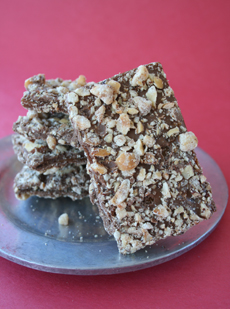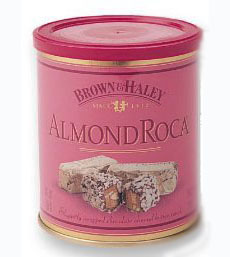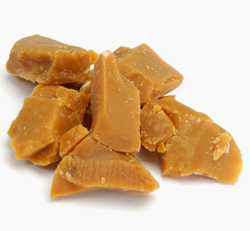

If it’s dipped in chocolate and covered with crushed nuts, it’s buttercrunch, not English toffee. Photo by Hannah Kaminsky | THE NIBBLE.
May 2006
Updated January 2018
|
 |
The Difference Between Buttercrunch & Toffee
Toffee Page 2: The Difference Between Toffee & Buttercrunch
This is Page 2 of a four-page article. Click on the black links below to visit other pages.
Toffee Versus Buttercrunch, Butterscotch & Caramels
What’s the difference between toffee and butterscotch? Toffee and taffy? And where does caramel fit in?
American-Style Toffee Is Buttercrunch
English toffee is a plain candy made of sugar and butter, sometimes with added nuts. Buttercrunch is toffee that is coated with chocolate and crushed toasted almonds.
Buttercrunch, also called almond buttercrunch, is an American invention. One of the best-known products is Almond Roca, launched in 1923 by Brown & Hale of Tacoma, Washington. (Roca means “rock” in Spanish. In those days, most almonds came from Spain and the name suited the crunchy center.)
The name may have been coined by William Loft, who began a confectionery in 1860 and sold almond-coated toffee (alas, the business closed in the 1990s).
|
|

The best known brand of buttercrunch. Purchase Almond Roca. |
Many producers of buttercrunch call their products “toffee” or “almond toffee”—or worse, English toffee—adding to the confusion. Classic English toffee is unadorned. Sorry folks, but if it’s covered with chocolate and nuts, it’s buttercrunch. Why do producers insist on calling it “English toffee?” Our guess is ignorance or because they think it will sell better. Are people entitled to call things what they want? We can’t give a legal opinion, but it’s like calling an apple tart an apple galette, when it isn’t a galette, which is a very specific type of crust. It is confusing and misleading to the consumer...but at this point, it’s a losing battle.
The Difference Between Caramels, Butterscotch & Toffee
Caramels are the softest of this group of candies, butterscotch is harder and toffee is the hardest. This is based on both ingredients and at how high a temperature the ingredients are boiled. Here’s a comparison:
- Butterscotch and toffee are made by combining sugar, butter and water.
- Classic English toffee has no other ingredients than those—no vanilla, no chocolate, no nuts.
- Butter toffee is a redundant term: Toffee is made with butter, except in situations where mass marketers substitute cheaper fats.
- Butterscotch and American-style toffee, as opposed to English toffee, can add vanilla and other flavorings. Butterscotch is then boiled to the soft-crack stage (270°F to 290°F on a candy thermometer), toffee to a hard-crack (295°F to 310°F).
|
|

Toffee, made in a slab and broken up. Commercial toffee is made in a mold. Photo by Fertnig Photography | IST. |
- Caramels add milk or cream (and sometimes, flavors) and are cooked at a lower heat, to the firm-ball stage (248°F). Both of these factors make them softer and chewier.
- If it’s soft, it’s caramel. There are numerous candies on the market called “toffee” that are actually caramel. More than a few caramel apples are erroneously called “toffee apples.” Feel free to point out to the vendor that if, in fact, there were toffee on the apples, you wouldn’t be able to bite into them.
Continue To Page 3: What Is Taffy
Go To The Article Index Above

|






